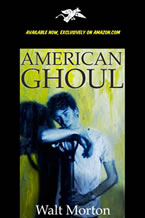Article first published as Book Review: American Ghoul by Walt Morton on Blogcritics.
December 28, 2012
American Ghoul
Walt Morton
Walt Morton (2012)
American Ghoul Full of Gothic Twists and Teenage Angst
 Howard Pickman is a lot like most teenage boys—a little nerdy, not exactly popular, very smart and just trying to make his way through high school—with one added problem. His family has a secret, and when that secret is discovered when the book opens, it results in Howard’s parents being torched to death and Howard fleeing in search of a safe place to begin his life over.
Howard Pickman is a lot like most teenage boys—a little nerdy, not exactly popular, very smart and just trying to make his way through high school—with one added problem. His family has a secret, and when that secret is discovered when the book opens, it results in Howard’s parents being torched to death and Howard fleeing in search of a safe place to begin his life over.
Howard’s secret is that he comes from a family of ghouls—not ghosts—for the Pickmans are flesh and blood people and not unlike anyone else except that they must eat human flesh to survive. They don’t even need to eat it frequently—Howard’s grandmother goes for years without it—but it results in her becoming weak and sickly. The Pickmans are not evil—they do no harm to humans. They simply rob graves and consume the newly dead to provide themselves with their needed sustenance—and that is how Howard’s parents were caught.
Being a ghoul is tough. Even after Howard escapes death and makes his way to his grandmother’s home in New Jersey, where he starts life and high school over, trying to fit in, he still has to rob graves for himself and his grandmother so they can live. He’s pretty good at grave robbing, but there’s always a risk.
What I most appreciated about American Ghoul was not necessarily its ghoulish context but how effortlessly Walt Morton works the Gothic elements into the story of what would otherwise be that of a typical teenage boy. I say Gothic because the novel is not really horror. The ghoul is the main character and the reader cheers for him—there is no supernatural force or creature for the reader or main characters to fear. The most evil things in the book are humans and a society that doesn’t understand ghouls, and especially a group of teenage boys who like to bully Howard and his nerdy friends who are starting up a punk band—it’s the early 1970s when punk was still taking off. The book’s real moments of horror all derive from being in high school and dealing with the bullies.
I also appreciated Morton’s use in the novel of the Gothic manuscript tradition. Howard’s grandmother gives him his grandfather’s letters from World War II, which reveal some interesting information about being a ghoul; Howard ponders this information and later it adds to the novel’s dramatic conclusion. Morton knows his Gothic tradition, using family secrets discovered in manuscripts to bring about a form of salvation—literal salvation in this case.
Finally, American Ghoul has plenty of humor enclosed in Howard’s interesting ghoulish perspective. He loves to watch old monster movies, but he feels sorry for the monsters, especially Godzilla, whom humans first waken and then decide to destroy when all Godzilla wants are answers for why they’re exploding an atomic bomb in his ocean lair. Howard also has interesting perspectives on writing—not being able to make much sense or find much value in William Faulkner’s inability to tell a story—and on religion, wondering whether Jesus might have been a ghoul also, considering he encouraged cannibalism among his disciples in the Eucharist, a ceremony Howard doesn’t really understand and which he mentally inverts in ways not too unlike Bram Stoker’s treatment of the Eucharist in Dracula.
Anyone wanting a refreshing story with a young voice full of humor and teenage angst, yet with all the Gothic trappings that have kept the genre popular for over two centuries would do well to give “American Ghoul” a try. It’s Morton’s first in an intended sextet of books in the supernatural horror genre, so don’t miss out and get left behind.
For more information on Walt Morton and American Ghoul, visit www.WaltMorton.com.
— Tyler R. Tichelaar, Ph.D. and author of “The Gothic Wanderer”

